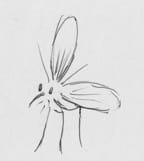Research interests
|
Malaria parasites make a living in some very unusual ways, and they have close and distant relatives that use very different strategies. Some malaria species specialize on humans, but other species exist that infect birds, reptiles, or other mammals like rodents. Malaria parasites are part of a large, parasitic phylum called the Apicomplexa. While malaria parasites rely on short-lived animals (mosquitoes, sandflies) to get from host to host, other Apicomplexans rely on other animals or the environment to infect new hosts. These species provide useful points of comparison that can help me understand why malaria parasites make a living as they do.
|
Sandfly
|
|
I use within-host models to map the consequences of curious parasite traits, drawing on theory developed for free-living organisms. Testing these predictions requires good methods for characterizing parasite strategies, which can be difficult or impossible to measure directly. I also use models to test out inference methods, meaning that I simulate data--so that I know the right answer--and then determine what methods are needed to give a clear picture of parasite biology. Here are a few of the traits I'm interested in:
Transmission investment. All Apicomplexans have to make special life stages for onward transmission, diverting resources away from the present host. Allocation to transmission should hugely alter parasite transmission success, but different Apicomplexans appear to resolve the tradeoff in varied ways—-what accounts for these diverse strategies? There are important seasonal changes and regional differences in mosquito availability. Does that shifting geography translate into differences in how parasites resolve these tradeoffs? Synchrony. Apicomplexans sometimes, but not always, seem to maintain a circadian rhythm in their life cycle within the host. In humans, malaria infection can result in periodical fevers, an outward sign of synchronized cycles of blood stage infection (where parasites invade red blood cells, develop, and burst out in unison). Can differences in synchrony be explained by host immune defenses, or the ecology of transmission? Or are these differences an artifact of the way synchrony is measured? |

